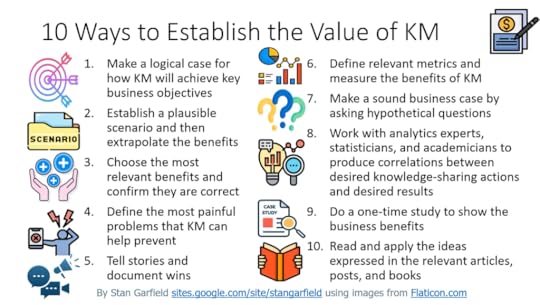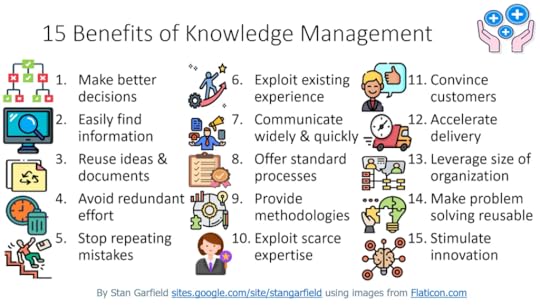The LEXICON Framework Part 3: 10 Ways to eXplain the Value of Knowledge Management

This is my third post in a seven-part series based on the compelling LEXICON Knowledge Management (KM) framework created by legal KM specialist Clare Bilobrk. LEXICON is an acronym for:
Link KM to daily workflowsEmpower championseXplain the valueIntegrate with existing systemsCultivate a knowledge-sharing cultureOptimize for ease of useNurture feedback loopsIn this post, I’ll focus on the third point:
10 Ways to Establish the Value of KM
eXplain the value — Clearly connect KM use to real-world benefits: reduced duplication, faster turnaround, higher-quality outputs, and better client service.
Explaining the value of knowledge management and establishing how your KM program will achieve that value are essential for gaining initial sponsorship and ongoing management support. Here are ten ways to do just that.
 1. Make a Logical Case
1. Make a Logical CaseMake a logical case for how the initiative will help achieve the key business objectives of the organization.
For example, if the business objectives are increasing profits, accelerating sales, and improving customer satisfaction, explain how the elements of the program will have a positive impact on these. If profits increase, sales accelerate, and customer satisfaction improves, and there is a rational explanation for how knowledge management supported these results, then take partial credit.
2. Establish a Plausible ScenarioEstablish a plausible scenario and then extrapolate the benefits.
For example:
If we save one project from repeating the same mistakes as previous projects, that could save $2 million, which will more than pay for the program. If we repeat this, the impact on profits is very large.If by responding quickly to an opportunity with a proven solution using acknowledged experts, we win one $10 million project that we otherwise would have lost, that’s incremental revenue of $10 million. If we repeat this, the impact on revenue is very large.If by ensuring that the best engineering product knowledge is reused, we avoid one product recall, we save the company hundreds of millions of dollars.This type of business case can be very persuasive. Note, though, you can’t prove that the sole cause of any outcome was KM, and you can’t prove that a costly recall was avoided if it never happened. But you can point out that the probabilities of positive outcomes are significantly increased through KM.
3. Confirm the Most Relevant BenefitsChoose the most relevant benefits from the list of 15 benefits shown below and ask the program sponsor to confirm that these are the right ones. Tailor your efforts to achieve these desired benefits.
 4. Define the Pain Points
4. Define the Pain PointsDefine the most painful problems that knowledge management can help prevent. Depending on the specifics of each scenario, examples could include:
Product recallsInjuries or deathsHarm to the environmentLawsuitsUnprofitable products and servicesLow employee moraleLost customersDamage to the brandInability to attract or retain talentFailure to achieve the organization’s missionDiminished productivity, revenue, growth, profit margin, market share, and shareholder valueBecoming a takeover target or going out of business5. Tell Stories to Show ValueBefore launching a program, tell stories that show the value it will provide. After the program starts, tell stories of early success, As the program matures, document wins using the voices of actual users.
6. Define the MetricsDefine relevant metrics for all stated objectives and report regularly on performance against those metrics. Pair operational metrics with business impact metrics and correlate good performance in the KM program with good results for the business. Measure the benefits of your KM efforts.
7. Make a Sound Business CaseHere are some examples of the questions you might ask when developing your case:
Do we want our people to be able to readily find deliverables from previous projects so that they can reuse them, and people who can provide useful advice on how to deliver the next one?Do we want anyone who has a question, seeks a resource, or requires help to be able to easily, quickly, and reliably get what they need?Do we want to avoid redundant effort, repeating the same mistakes over and over, and keeping important information from reaching the very people who need it?Do we want to stop making poor decisions, failing to innovate, and losing our organizational knowledge as people resign and retire?8. Correlate Actions and ResultsWork with analytics experts, statisticians, and academicians to produce correlations between desired knowledge-sharing actions and desired results, including employee advancement, project success, and financial results.
For example, Kai Riemer of the University of Sydney published a paper that states “a range of empirical studies in organizations have shown that this type of social capital (online collaboration) is associated with better individual performance evaluations, greater promotion chances and higher compensation payments as well as an increased team performance”
9. Conduct a StudyDo a one-time study to show the business benefits.
Caterpillar commissioned a one-time study by an independent consulting firm to identify the benefits and ROI for two established communities of practice: Joints and Fasteners and Dealer Service Training. The results were:
Qualitative ROI: Productivity (up 40%), Cost (reduced 25%), Speed (up 15%), Quality (up 4%)Tangible ROI: 200% for internal CoPs; 700% for external CoPsBased on these results, the Caterpillar KM program was justified. There was no need for ongoing collection and reporting of ROI, since it had been done once.
10. Apply Lessons from Existing ResourcesI encourage you to read and apply the ideas expressed in my book on this subject and in the blog posts taken from the book:
Proven Practices for Promoting a Knowledge Management Program Selling the benefits of knowledge managementProven practices for making the KM business caseBenefits of Knowledge Management, Part 1Benefits of Knowledge Management, Part 2Next post — Part 4: Integrate with existing systems
[image error]


